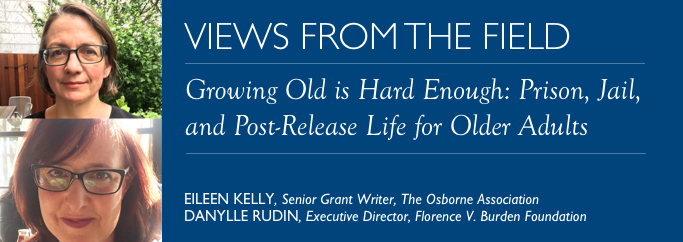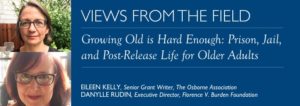
A Shift in Perspective
Sometimes a shift in perspective leads to far-reaching innovations, whether in policy, programs, or grantmaking.
Imagine a ward full of elderly people, some who use walkers, others who lie in hospital beds, believing they are back in their childhood homes. Shift your perspective, and see that these older adults are in prison, aging and dying in one of the specialized units created to manage the growing population of incarcerated elders.
Or imagine passing one of the older people who make their beds on unfolded cardboard boxes on our cities’ sidewalks. Shift your perspective, and see that this person has just exited a jail, where she was locked up for jumping a subway turnstile or committing an “offense” of the poor.
Prisons and jails in the United States are “graying,” as documented in a 2014 report of the Osborne Association, The High Costs of Low Risk: The Crisis of America’s Aging Prison Population. By 2030, older adults are expected to account for one-third of all incarcerated Americans.
That researchers consider people to be “older prisoners” starting at age 50 or 55 points to a hard truth: incarcerated people are physiologically older than their same-age counterparts outside of prison. Pre-existing factors—such as lack of health care, substance abuse, and exposure to disease—mean these individuals enter incarceration “older” than their chronological age. Prison life itself—including poor diet, sedentary lifestyle, inconsistent health care, and unrelenting stress—mean that individuals age more rapidly once behind bars. In prisons and jails, 50 is the new 65.
Incarcerating an older person is expensive. In addition to typical costs associated with aging, correctional budgets must cover the special vulnerability of incarcerated elders and the steep expense of providing specialized treatment behind bars. Incarcerating an older person can also be cruel. Correctional institutions are unforgiving environments. As older adults’ hearing, sight, and mobility decline, they may fail to comprehend correctional officers’ orders or follow them quickly enough. They may be required to climb to top bunks, stand for head counts, or walk distances to reach their meals. Aging people may experience dementia and urinary incontinence, making them more vulnerable to ridicule and abuse.
Key Difference between Prisons and Jails
The term “incarcerated” covers two groups: people in prisons and people in jails. Jails hold men and women awaiting trial or serving short sentences, typically of less than a year. Prisons hold people serving longer sentences, from just over a year’s imprisonment to life without parole. Typically, older adults in prison have grown old there. Although these elders are incarcerated for serious offenses, they pose little threat to public safety.
Nationwide, data show a steep drop-off in criminal activity by the time a person turns 50, while individuals over 65 have the lowest recidivism rate of all demographic groups. The exception is found among older adults in jails, who are accused or convicted of recent offenses. These are people who cycle in and out of confinement, their conflicts with the law driven by homelessness, poverty, substance abuse, and mental illness. These older adults are often jailed for acts that amount to criminalized poverty, such as when a homeless person with nowhere to sleep is arrested for “trespassing.”
An older adult who reenters the community after decades’ imprisonment experiences the dislocation of a time-traveler. An older person who reenters after a short jail stint may well be returning to an impoverished life that is all too familiar. Both are likely to have frayed family ties, one from the years spent apart, the other from the effects of repeated separation.
For those elders whose family ties remain intact, going home may still not be an option, due to laws that bar most people with felony convictions from public housing. Thus, we find formerly incarcerated older adults overlapping another growing population: homeless older adults. As the United States population ages, the number of homeless elderly is expected to soar. Data indicate that homeless elders are likely to have criminal histories, and that simply being homeless steeply increases their chances of being re-incarcerated.
A bed for the night may be the most urgent concern for formerly incarcerated elders, but it is not the only one. Medicaid, food stamps, and other supports await the slow process of reinstatement. Older adults quickly use up the medications with which they were released. Assisted living centers and other strands of the safety net are not equipped or willing to meet their needs. Add to this the fragility, cognitive impairment, and hearing, sight, and mobility problems that often accompany old age, and we have a desperate situation
An Innovative Response
In 2015, the Osborne Association designed the Elder Reentry Initiative (ERI) to address the needs of older adults making the transition from incarceration to life in New York City. Osborne was well-equipped to take on this challenge. Founded in 1933 to honor the legacy of prison reformer Thomas Mott Osborne, the nonprofit works in criminal courts, 27 state prisons, as well as in community sites in the Bronx, Brooklyn, Upper Manhattan, and Newburgh, New York, serving 10,000 people each year. Osborne’s programs help men and women find and keep jobs; reconnect with and parent their children; enter and stay in recovery; manage HIV/AIDS and other chronic illnesses; and rejoin and contribute to their communities.
With a planning grant from The Florence V. Burden Foundation, ERI was piloted at two men’s prisons, Fishkill and Sing Sing Correctional Facilities. Participants ranged between 60 and 82 years old, and most had served more than 25 years in prison—one had served 45. At the city’s invitation, the program expanded to Rikers Island jails in 2017.
Using its established presence inside correctional institutions and in communities, Osborne designed an intervention that spans the reentry experience, from life behind bars to life in a new home. Inside correctional facilities, ERI staff employ an assessment instrument that combines geriatric and criminal justice perspectives. Staff then develop transitional plans that focus on housing, but surround housing placements with a nest of supportive services.
ERI’s community-based staff support older adults through their first days and nights after release, and provide case management to ensure the implementation of their discharge plans. ERI also conducts outreach and technical assistance to address the larger need for competent community resources willing to serve these older adults. Osborne’s policy experts support this work by educating policymakers about the opportunity to invest in innovative solutions like ERI.
ERI was developed through a planning grant from The Florence V. Burden Foundation, a family foundation based in New York, New York. In an effort to improve the lives of those in need, the foundation focuses its giving in three programmatic areas: children, youth and families; aging and senior services; and criminal justice. This includes addressing the needs of incarcerated people of all ages and their families.
The Florence V. Burden Foundation is one of a few philanthropies in the country focused on the needs of older incarcerated people. This includes the challenges older adults face as they age in prison as well as the challenges faced by those released following decades of incarceration. The foundation believes that current trends in prison reform are an opportunity to alter the “aging landscape” for older adults involved with the criminal justice system.
What Can Health Funders Do?
- Support changes in law and policy. Oppose housing policies that discriminate against formerly incarcerated older adults. Support policies that promote reasonable parole and compassionate release for the aging.
- Re-examine grantmaking priorities. Incarcerated or formerly incarcerated older adults are at risk of homelessness, dementia, HIV/AIDS, diabetes, geriatric syndromes, and chronic illnesses. Shift your perspective to examine how grantmaking priorities can include these older adults.
- Ask questions of your grantees. Do funded organizations welcome older adults with criminal records? Do they know the extent to which formerly incarcerated older adults are among those they serve? Would grantees be willing to serve these older adults, given assistance that enabled them to do so competently?
- Learn more and educate others. Read The High Costs of Low Risk: The Crisis of America’s Aging Prison Population and similar publications—and look out for the updated report in early 2018. Work to shift your colleagues’ perspectives, too.

